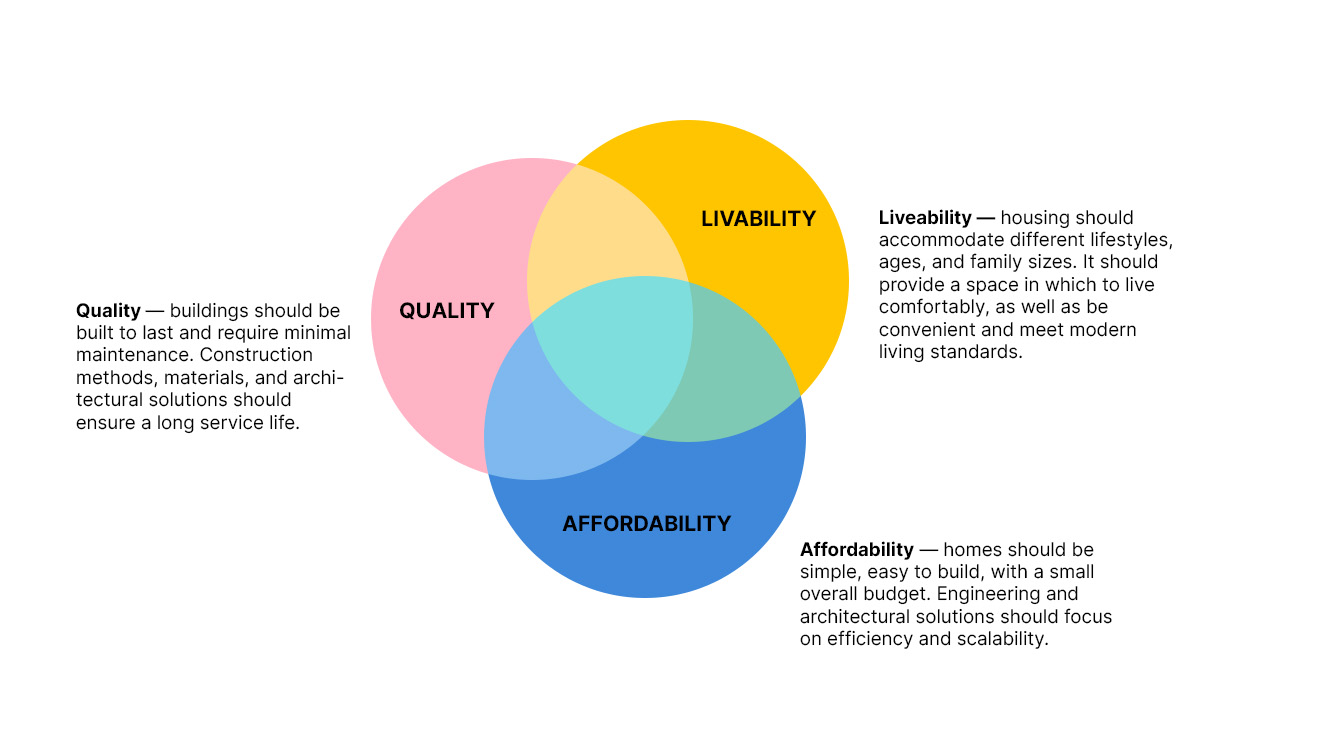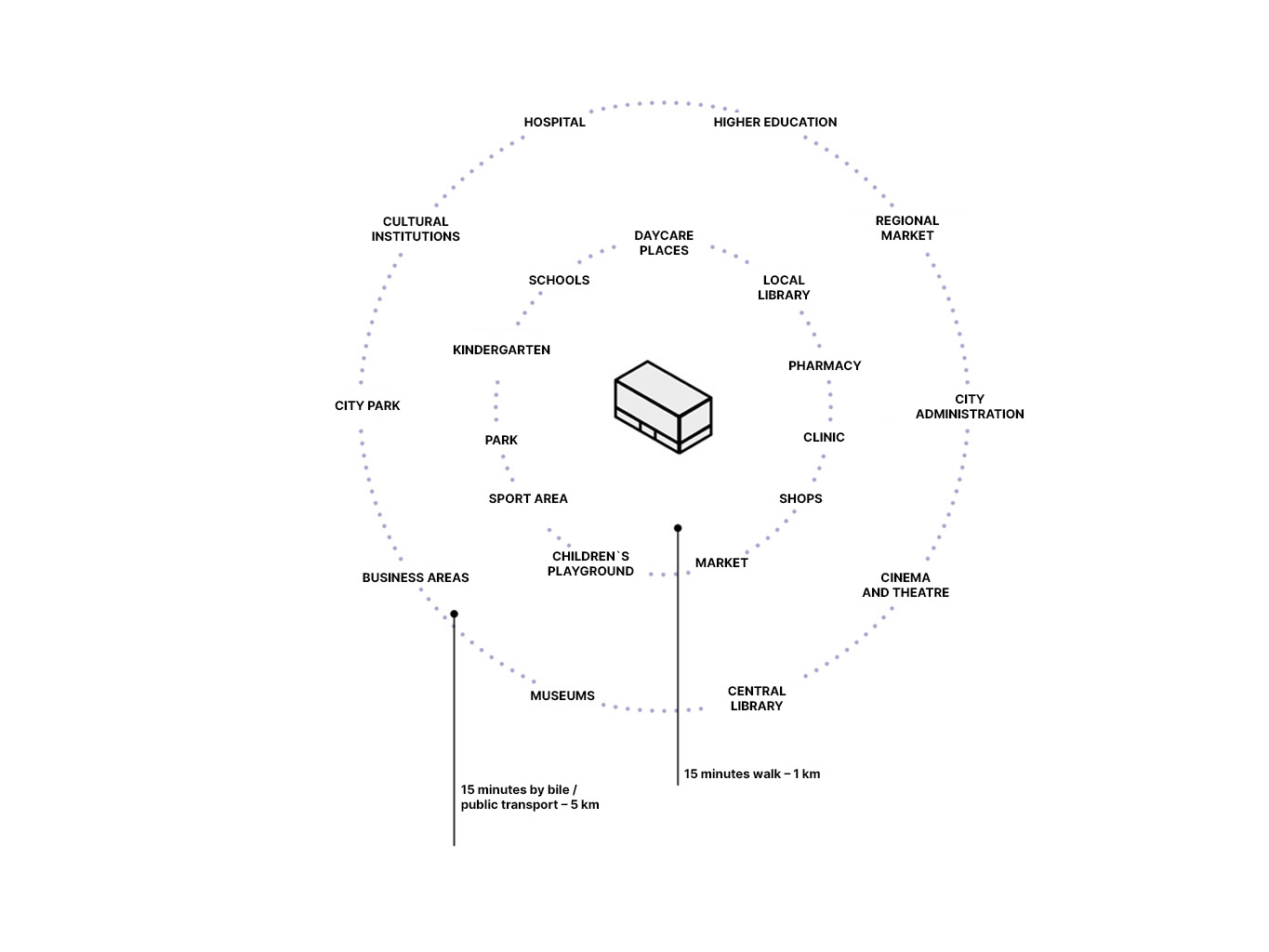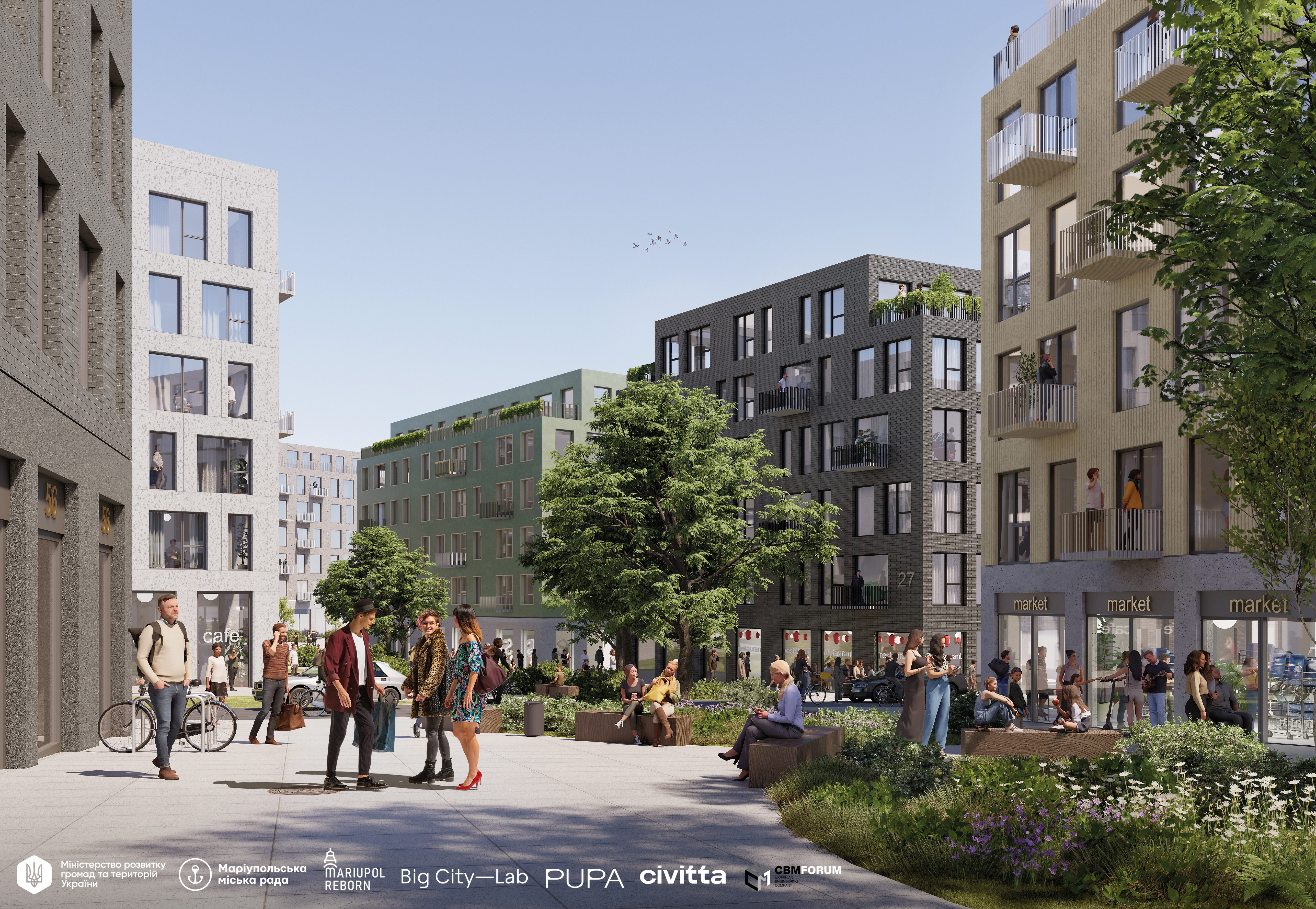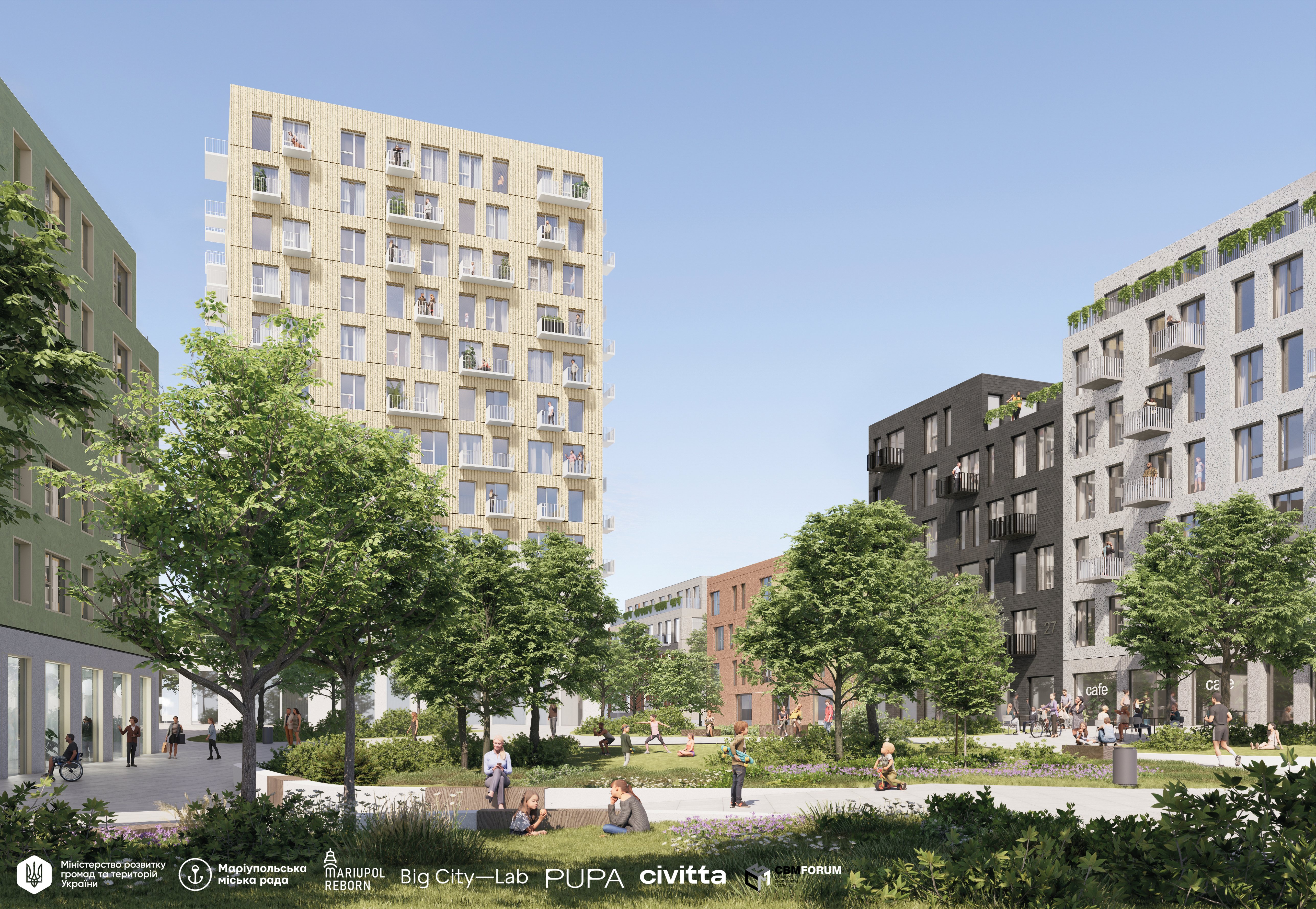
The project was implemented at the request of Oleksiі Kuleba, Deputy Prime Minister for Restoration of Ukraine, as part of the national initiative to develop social housing in Ukraine. The concept of social and affordable housing was developed jointly by the team of Mariupol Mayor Vadym Boichenko and the urban bureau Big City Lab, in partnership with the architectural studio PUPA and the consulting firm Civitta — within the framework of the Mariupol Reborn project.
The concept of new social housing in Ukraine is a comprehensive model for providing housing to those Ukrainians who need it most. It was developed at the request of the Ministry of Community and Territorial Development of Ukraine, which is the initiator and key partner in the implementation of the housing project.
The proposed model combines architectural solutions, management principles and financing. It provides for the construction of high-quality, barrier-free and affordable housing, which will be rented at a fair price below market value and integrated into the urban environment as a full-fledged part of the community.
The first social housing pilot project will be implemented in Bila Tserkva: a neighbourhood of ten buildings will provide housing for about 1,500 Ukrainians who have lost their homes.
Context
Since the start of Russia's full-scale invasion of Ukraine, millions of people have been forced to leave their hometowns and move to safer regions of the country or abroad. As of 2024, around 3.1 million Ukrainians are internally displaced persons in need of housing.
Traditional market mechanisms do not solve the housing crisis: the rental market is in the shadows, the cost of buying apartments is rising, and the country's housing stock is suffering new damage every day. It is for this reason that the concept of new social housing in Ukraine was developed.
Project
Social housing is not only a response to today's challenges and a long-term strategy for providing housing to those in need. It is also an opportunity for people to live with dignity, feel protected, and be part of a community.
Therefore, the concept developed is based on the construction of a new type of housing that will meet people's needs and be affordable both in terms of implementation and operation. The guidebook ‘Social Housing in Ukraine: Creating a Home’ describes the concept and new standard for creating social housing in Ukraine, which will enable the high-quality and efficient construction of affordable housing throughout the country.
While working on the project, the team researched the housing market in Ukraine, how it has developed over the last few decades and what problems it faces today. International experience was also analysed: both countries that began building social housing immediately after World War II and those where these processes started after the collapse of the Soviet Union. It also explains in detail how social housing can be built, who can manage it and how it can be financed.
{{slider-58="/en/sliders"}}
What we researched
The Big City Lab team analysed housing policy in Ukraine during the Soviet era and after the country gained independence. We researched the current situation, namely the needs of internally displaced persons and vulnerable groups. We also analysed international experience to understand how to adapt effective models to the Ukrainian context.
The countries whose housing policies we studied can be divided into two groups:
{{slider-59="/en/sliders"}}
What management model for new social housing do we propose?
The management of social housing should be entrusted to housing companies for the common good (HCCGs), organisations that build, manage and maintain housing facilities with a focus on social benefit rather than profit. Their goal is to provide affordable and quality housing for various groups, including the low-income, socially vulnerable and those with individual needs.
HCCGs can be established by local government bodies, public organisations, private companies, etc.
Housing companies for the common good are a common practice in Europe (Austria, the Netherlands, Poland), as well as in the United States, Canada and Australia.
Main functions of the HCCGs in the area of management

Thus, the model we have developed is profitable. All profits received by the HCCGs are directed towards maintaining existing social housing and constructing new housing.
Architectural and urban planning solutions
When developing architectural and urban planning solutions, our team formulated the following main research question: How to plan the construction of 250,000 high-quality and affordable social housing units in Ukraine?
First of all, we identified three key aspects of social housing:
Quality: houses must be built to last and require minimal maintenance costs. Construction methods, materials, and architectural solutions must ensure a long service life.
Livability: housing must suit different lifestyles, ages, and family compositions. It should provide a comfortable living space that is convenient and meets modern living standards.
Affordability: houses should be simple, easy to build, and have a low overall budget. Engineering and architectural solutions should focus on efficiency and scalability.

Minimum furnishing requirements
Social housing should offer flexible solutions for kitchens, living rooms, bedrooms and other areas. It is important to strike a balance between functionality and minimal sizes in order to use space efficiently and ensure comfort for residents.
{{slider-60="/en/sliders"}}
Land resources
Land is one of the most important aspects of urban development planning, particularly the development of social housing in cities. All decisions must take into account the efficient use of land, optimisation of building density, access to infrastructure, and ensuring a balance between residential areas, public spaces, and green spaces.
Various factors influence the amount of land available for social housing projects, such as housing needs, the cost of renting or purchasing land, its location in the city, etc. Therefore, it is essential to decide on the type of development: will it be compact solutions such as townhouses or large-scale multi-storey complexes?
{{slider-61="/en/sliders"}}
Choosing a location for social housing construction
Social housing is not just about square metres, but about the opportunity to live, work and develop with dignity. Therefore, it should not be located on the outskirts without infrastructure, but should become part of a well-thought-out urban environment.
When choosing a location for construction, one should focus on the concept of a 15-minute city — where all the basic needs of residents (work, education, leisure, services, shopping) can be met within a 15-minute walk or bike ride.
This is not only about convenience, but also about the efficient use of resources and stronger ties within the community.

A typical social housing block
The concept envisages that one social housing block will contain 233 apartments with a total living space of 9,900 m². Within one block, there should be buildings of different types, and the apartments in them should have different layouts.
This approach guarantees diversity of choice and meets the needs of different families with different economic opportunities, lifestyles, composition of residents, etc.
{{slider-62="/en/sliders"}}
Case study in Lviv
When developing architectural and urban planning solutions, we conducted a case study using the example of a plot on Hlynianskyi Trakt Street in Lviv. Currently, there are several unfinished buildings here, and the city authorities are already planning to renovate them as part of the microdistrict's master plan.
{{slider-63="/en/sliders"}}
For this site, we developed our own architectural and urban planning solution for the construction of a social housing block.
Our solution is a well-thought-out model of a neighbourhood that complies with quality standards and provides everything necessary for a comfortable life. The neighbourhood has a clear street structure without dead ends, which facilitates movement for pedestrians and transport.
At the same time, we have established a distinction between public and private spaces. The main streets lead to housing, public spaces and green areas, while the inner quarters form a more private environment for residents. This is an example of how architecture can simultaneously meet basic needs and create a high-quality and comfortable living space.

The blocks feature buildings of varying heights and types, and each neighbourhood contains green areas located in inner courtyards.

The concept envisages the construction of new facilities, including a school, which is accessed by a pedestrian walkway that runs through all the neighbourhoods. There are also plans to create a new park, which will become a large green area for the residents of the district.

The housing estate project involves the construction of 1,632 housing units. One part of the construction is private development, and the other is allocated for social housing.
It can be concluded that the project could accommodate 650 social housing units, which is 40% of the total development.
A pilot social housing project will be built in Bila Tserkva: a block of ten buildings will provide housing for about 1,500 people. The apartments are planned to be renovated, furnished and equipped with household appliances.
{{book-14="/en/book-banners"}}